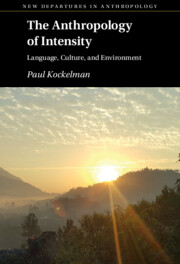Book contents
- The Anthropology of Intensity
- New Departures in Anthropology
- The Anthropology of Intensity
- Copyright page
- Dedication
- Contents
- Figures
- Tables
- Acknowledgments
- Abbreviations
- Introduction: Intensity
- Part I Grounds
- Part II Tensors
- Part III Thresholds
- Nine Temporality and Replacement
- Ten Temporal Thresholds
- Eleven Modality and Worlding
- Twelve Modal Thresholds
- Conclusion: The Ecological Self
- References
- Index
Eleven - Modality and Worlding
from Part III - Thresholds
Published online by Cambridge University Press: 05 May 2022
- The Anthropology of Intensity
- New Departures in Anthropology
- The Anthropology of Intensity
- Copyright page
- Dedication
- Contents
- Figures
- Tables
- Acknowledgments
- Abbreviations
- Introduction: Intensity
- Part I Grounds
- Part II Tensors
- Part III Thresholds
- Nine Temporality and Replacement
- Ten Temporal Thresholds
- Eleven Modality and Worlding
- Twelve Modal Thresholds
- Conclusion: The Ecological Self
- References
- Index
Summary
Chapters 11 is about modality in Q’eqchi’-Maya – various resources speakers have for referring to entities and events that are nonactual, and hence notions like possibility, permission, necessity, and obligation. It focuses on the forms naru and tento, which are similar in function to the modal auxiliary verbs in English: naru doing work akin to English ‘may’ and ‘can’ (or deontic, dynamic, and circumstantial possibility), and tento doing work akin to English ‘must’. It offers a detailed examination of how speakers use such forms to represent and regiment what counts as obligatory, forbidden, permissible, and possible courses of action.
- Type
- Chapter
- Information
- The Anthropology of IntensityLanguage, Culture, and Environment, pp. 298 - 326Publisher: Cambridge University PressPrint publication year: 2022

